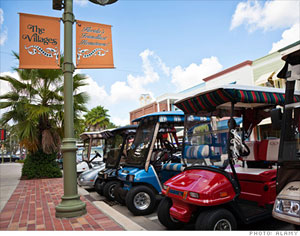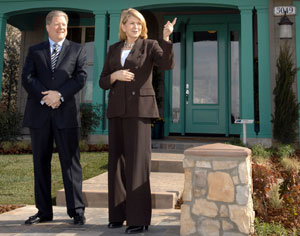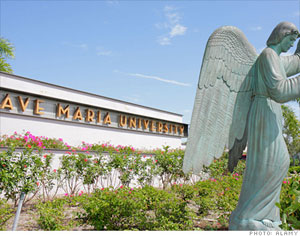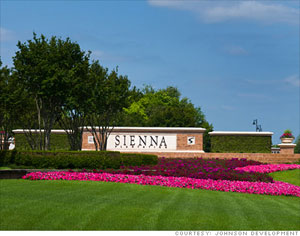Whether it’s a religious calling, a golfing itch or Disney-developed serenity, millions have found a way of life in communities that amount to mini worlds.
There’s no place like your centrally planned home
For a citizenry obsessed with personal freedoms, it’s amazing how many of us live in manufactured environments. But just as art and culture draws urbanites to America’s major cities, suburbanites flock to some of the largest planned communities in search of that special something. It’s not just for the space, the pace, or the pool, either. Whether it be a religious calling, a golfing itch or Disney-inspired serenity, millions have found a way of life in communities that amount to miniature worlds. Here’s a glimpse of some of them, highlighting the quirks that make them worthwhile places to live.
 The Villages: Children not optional
The Villages: Children not optional
Location: Central Florida
Think of the hit television sitcom, “Leave it to Beaver.” Only there’s no Beaver. And Ward Cleaver is at least 56 years old and cruises around in something that looks like a cross between a golf cart and a Bentley. At The Villages, there can be no permanent residents under 19 years old. At least one person must be over age 55 in every household. Children who visit can’t stay longer than three weeks at a time.
Gary Morse, the developer, has truly designed a utopia of sorts for so-called active retirees: The type who no longer work but eager to go dancing, play a round of golf and squeeze in a game of mah-jongg before dining out with neighbors. Morse owns just about everything at The Villages, including the local radio station that pipes oldies music out of lamp posts and fake rocks at the two downtowns. The developer also owns a full-sized newspaper called The Villages Daily Sun.
At one and half times the size of Manhattan with about 80,000 residents, the community was designed so that golf carts trump automobiles as the preferred mode of transportation. At prices ranging under $150,000 to more than $1 million, all this has made the massive community the it place for leisurely retirement.
 Twin Lakes: Martha Stewart’s Living (Really)
Twin Lakes: Martha Stewart’s Living (Really)
Location: Cary, NC
For the style conscious, Twin Lakes attempts to bring to life the domestic fantasies peddled in Martha Stewart’s Living magazine.
In this 650-home neighborhood, Stewart brings inspiration from her own homes in New YorkConnecticut and Maine to this affluent southern suburb aptly nicknamed “Concentrated Area of Relocated Yankees.” Shortly following Stewart’s 5-month prison stay for lying to authorities about a stock sale, KB Home (KBH) partnered with Martha Stewart Living Omnimedia Inc. (MSO) in 2005 to build Twin Lakes: New Homes Created with Martha Stewart. state,
The timing was awkward, but hardly surprising for this iconic homemaker known for simplicity and style in everything from sheets to gardening tools. Twin Lakes features townhomes and single-family dwellings based on inspirations of Stewart’s design team — everything from wainscoting to light fixtures to paint colors and flooring. Stewart advised on the homes’ floor plans, which include larger laundry rooms, well organized closets as space for indoor and outdoor entertaining. Stewart’s homes have caught on in developments in Florida, Illinois, California and Colorado.
So if you’re looking for something that looks almost too perfect to live in, then Twin Lake might just be that too perfect a place.
 Celebrate good times. Every day.
Celebrate good times. Every day.
Location: Celebration, FL
With its candy-colored town center and a touch of Walt Disney magic, the master-planned community of Celebration tries to live up to its name. The town was inspired by Walt Disney’s 1966 dream for an experimental prototype community of tomorrow, also known as EPCOT. While EPCOT became just another theme park within the Mickey Mouse empire, Walt Disney’s dream for a pedestrian-friendly utopia became a reality — complete with schools, hospitals, and businesses — in the mid-90s under then-Disney CEO Michael Eisner.
But perfection, at least the appearance of, comes with a price and lots of rules. The development has strict town-wide policies in place for its 3,500 residences — such as limitations on political signage during elections and rules regarding lawn plants as stipulated in a “Declaration of Covenants,” a lengthy agreement that requires the signature of every Celebration homeowner.
The town really is a “celebration of all the best aspects of American urbanism and architecture,” insists Jacquelin T. Robertson, a principle at Cooper, Robertson & Partners, a firm which undertook a joint venture with prestigious Robert A.M. Stern Architects to design and oversee the construction of the estimated $2.5 billion plan in 1994.
 Ave Maria: Holy planned community
Ave Maria: Holy planned community
Location: Naples, FL
Ave Maria was born out of the mind of an unlikely developer and even less likely concept.
In 2003, Domino’s Pizza (DPZ) founder Tom Monaghan sought to build the first Catholic university in the United States in decades to “produce the future faithful educators, leaders, and mentors that our challenged society needs.” It was his idea that sparked the interest of Barron Collier Companies to build a mega community that would eventually include 11,000 households spanning more than 5,000 acres.
Like most mega communities that encourage residents to “live, work and play,” Ave Maria includes a grocery store, gas station, bank and post office. But the centerpiece and what appears to be the big draw is Ave Maria University, which offers theology, sacred music and other courses committed to Catholic principles. While a private Catholic K-12 school accompanies the University, the community insists it is non-denominational and “open to every religion, ethnicity and age.”
 Sienna Plantation: Green acres
Sienna Plantation: Green acres
Location: Missouri City, TX
Who knew that former plantations were apparently good places to set up master-planned communities? And perhaps even to name after?
For starters, Sienna Plantation in Missouri City, Texas, a project of The Johnson Development Corp. The plantation was first settled in 1824. Over time, it became Waters Plantation, growing into a 6,500-acre area growing sugar cane and cotton crops.
But sugar and cotton no longer sprout in this mega-community, which hopes to one day have 20,000 homes and 70,000 people. The Greater Fort Bend Economic Development Council estimates about 20,000 people currently living in the community. Now sprawling over 10,500 acres, the land is seeded with parks, golf courses, nature reserves, and water parks, among other amenities. To help take care of the massive area and keep the parks and trails alive and well, the Texas Parks and Wildlife Department invested $1.2 million in grants.
Did you know that if you subscribe to our website, you will receive email notifications whenever content changes or new content is added.
1. Enter your e-mail address below and click the Sign Me Up button.
2. You will receive an email asking you to confirm your intention of subscribing to our site.
3. Click the link in the email to confirm. That’s all there is to it! Note: if you wish to unsubscribe from our site, click the unsubscribe link at the bottom of the email you received.
Then indicate you no longer wish to receive our emails.
Thank You
Prisonbreakfreak.com Team